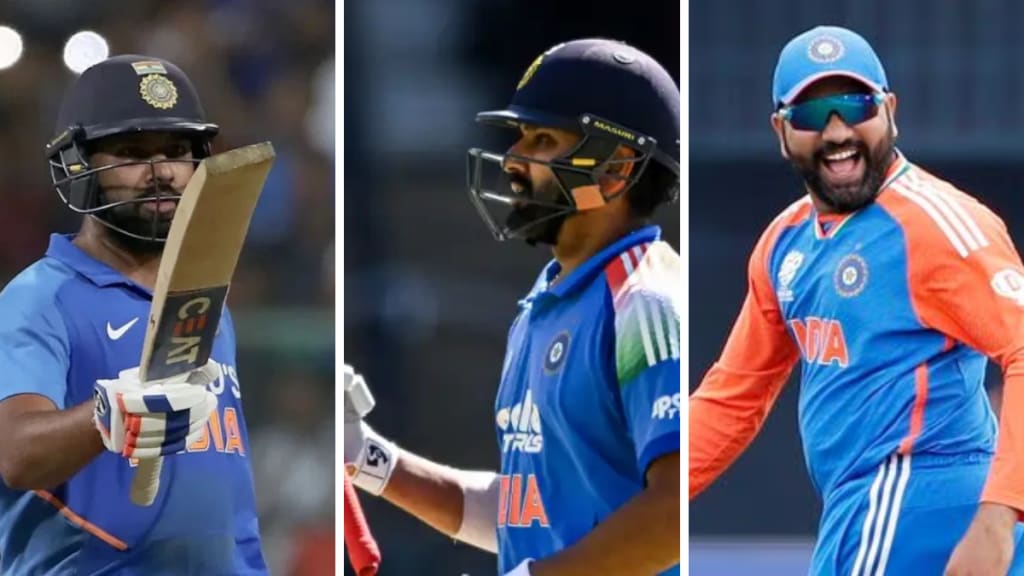Every generation of Indian cricket seems to have one player who carries calmness like armour. For this one, it’s Rohit.
He doesn’t shout on the field, doesn’t seek attention, doesn’t try to look dramatic for the cameras. You might even mistake that silence for detachment until the bat starts talking. And when it does, it speaks a language no one else can.
Think back to June 2007, when a 20-year-old Rohit Sharma made his ODI debut. That was a completely different world of Indian cricket. Rahul Dravid was still in his prime years, captaining the team. Gautam Gambhir, who is now India’s head coach, had played only 22 ODIs then. And Ajit Agarkar, who now sits on the selection panel, was still trying to prove his worth as a senior player in that same squad.

That debut, all those years ago, was supposed to be the start of something promising. But no one, not even Rohit himself, could have imagined that 18 years later, he’d still be here, leading India, still scoring, still adapting, still relevant.
For years, he’s been the artist in a room full of fighters, timing the ball so late it feels like time bends around him, pulling pacers off the back foot when most batters would still be ducking. His batting has rhythm, not noise. What really makes Rohit Sharma special is how he keeps that rhythm alive year after year, match after match, while the world around him keeps changing.
He’s seen his peers retire, new faces rise, formats evolve, fans divide. Yet he remains the same lazy elegance, same focus, same hunger.
Early Life That Taught Him Patience
Before he became “Hitman,” he was just Rohit, a quiet boy from Borivali.
His parents couldn’t afford much. His father worked as a caretaker in a transport firm, and his mother ran the house. The money was never enough, so Rohit stayed with his grandparents and uncle, visiting his parents on weekends. That separation wasn’t easy, but it gave him something more valuable: discipline.
To afford his cricket gear, he delivered milk packets around the neighborhood. Not for sympathy, not for headlines. Just to keep playing.
That early grind shaped him in ways stats never can. It made him value every chance, every small opportunity. So when life threw heartbreaks at him later, he already knew how to wait.
In 2011, when India won the World Cup, Rohit wasn’t in the squad. He was among the shortlisted names, but at the final moment, the management went with an extra spinner instead. It crushed him. Months before that, he had twisted his ankle just before his Test debut, another moment snatched away when it was almost his.
For most, two blows like that early in a career would have changed everything. For Rohit, it just became fuel.
The Turning Point No One Saw Coming
2013 changed everything. MS Dhoni asked him to open the innings. It was meant to be a temporary move, a small tactical switch for a series against England. But that one chance became the start of a new era.
In his first six years, Rohit had played 100 ODIs, scoring just 2480 runs at an average of 31.8 and a strike rate of 75, with only two hundreds. There was no hint that this man would one day become the finest ODI opener of his generation.

Since that change in role, his numbers look like they belong to another player altogether:
• 9219 runs as an opener in 186 innings
• Average: 54.5
• Strike Rate: 96
• Centuries: 30
To give context, Virat Kohli, the fastest to reach 9000 career runs in ODI history, did it in 194 innings. Rohit, opening only since 2013, crossed 9200 runs eight innings earlier. He has scored a century once every six innings since opening, and no one in world cricket with that many runs has matched that ratio.
Among all 54 openers in ODI history with 3000 or more runs, Rohit is the only one averaging above 50. The only one.
He didn’t just fit into the opening role, he owned it. From a player fighting for a spot, he became the most reliable ODI opener of this era.
Consistency That Looks Effortless but Isn’t
Rohit’s batting has a strange calmness to it. It doesn’t feel forced, it doesn’t feel rushed. Maybe that’s why people sometimes mistake it for “lazy elegance.” But behind that ease lies years of patience, drills, fitness, and discipline.
Since 2013, Rohit’s yearly ODI averages paint a picture that looks unreal when you read it out loud:
2013 – 52.0
2014 – 52.54
2015 – 50.93
2016 – 62.66
2017 – 71.83
2018 – 73.57
2019 – 57.30
2020 – 57.00
2021 – 30.00 (3 innings only)
2022 – 41.50
2023 – 52.29
2024 – 52.33
2025 – 38.3 so far
That’s more than a decade of batting above 50 in almost every single year. No streaks, no purple patches, just rhythm, patience, and discipline.
He’s also gone past Sourav Ganguly in ODI runs, standing among the top Indian run-getters of all time. What makes his record more meaningful is that he didn’t start his career as an opener. He spent nearly one-third of it struggling in the middle order before reinventing himself.
When Big Scores Became His Signature
Rohit doesn’t make hundreds. He builds mountains.
He has 32 ODI centuries, and 16 of them are 130 or more. That’s half of his hundreds turned into massive match-defining scores. He’s made eight scores of 150 or more, the most by any batter in men’s ODI history. And three double hundreds, the only man to cross 200 three times in the format’s 50-year history.
When he gets in, he doesn’t stop. There’s a quiet ruthlessness in how he keeps batting, slowly dismantling attacks without ever looking hurried. His 264 against Sri Lanka in 2014 remains the highest score ever in ODIs, but it wasn’t a one-time miracle. It was part of a pattern.
Captain Without Drama, Leader Without Ego
When Rohit became India’s captain after Virat stepped down, he didn’t walk in with slogans or fiery speeches. He walked in with a plan. His way of leading has always been to simplify things, give players clear roles, keep the energy calm, and trust his teammates.
Under his leadership in ODIs:
• Matches as captain: 56
• Wins: 42
• Win Percentage: 75% (Best in the last 40 years among captains with 50 games)
• Runs as captain: 2506
• Average: 53
• Strike Rate: 112
He and AB de Villiers are the only two captains in history to have an average above 50 and a strike rate above 100 after captaining in at least 50 ODIs.
Rohit’s calmness often hides how sharp he actually is as a tactician. He reads bowlers early, adjusts fields quietly, and uses matchups almost instinctively. What stands out, though, is how he backs his players. He doesn’t show emotion for the cameras, but you can see the respect in the dressing room.
Still Hungry, Still Changing
The real measure of a player is what they do when the world starts saying, “He’s done.” Rohit heard that a few years ago. He didn’t reply with words. He replied with transformation.
Many players slow down after 35. Rohit went the other way. Since turning 35, he has scored nearly 2000 runs in ODIs at an average of 49.6 and a strike rate of 117, the highest by any Indian in that age group.
He completely changed his batting approach too. Instead of playing himself in, he began attacking in the first 10 overs, something he hadn’t done for most of his career. At first, it didn’t always work. But he stayed with it, understanding that the team needed him to set the tone up front.
That’s the thing about him. He doesn’t care about protecting his personal record. He plays for the situation, even if it means he’ll fail sometimes.
Ahead of the India vs Australia series, he also shed 11 kilograms through a strict diet and intense gym training. This wasn’t about appearance. It was about readiness. After nearly two decades in international cricket, he still pushes himself like someone chasing a debut.
At Adelaide, when India were struggling at 24 for 2 after nine overs against Australia with the ball moving in all directions, Rohit stayed. Both Shubman Gill and Virat Kohli had fallen in the same over. He absorbed the conditions, picked his moments, and took India to 135 for 2 by the 29th. A quiet, technical show that spoke more than any big score could.
A Greatness That Doesn’t Need Noise
Rohit Sharma doesn’t respond to outside chatter. He doesn’t argue with opinions. He doesn’t celebrate too much when people praise him either. He just continues to bat the way he has always batted, with calm eyes, sharp mind, and soft wrists.
He’s gone past Sourav Ganguly’s tally of ODI runs, stands among India’s top scorers of all time, and remains one of the most complete openers the world has seen, averaging above 50, striking near 100, and winning matches across conditions.
He’s seen new stars rise, seen formats change, seen criticism come and go. Yet his focus never wavers. Whether he’s 19 or 38, whether he’s playing a final or a bilateral, Rohit’s eyes still look the same, relaxed but burning inside. For him, the game has never been about proving someone wrong. It’s about doing the thing he loves the right way, for as long as he can.
He started from nothing, missed chances, fell behind, came back, and then kept finding new peaks long after others thought he’d reached the last one. Some players play for records. Some for recognition. Rohit plays for rhythm, for that one perfect sound when the ball meets the middle of his bat.
And as long as that sound keeps echoing, he’ll keep going, no matter what’s happening around him.

